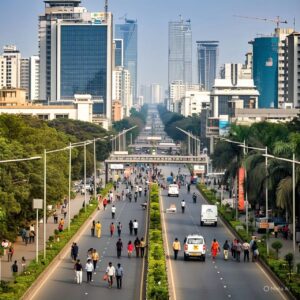Bangalore, known as the Silicon Valley of India, is now stepping into a new role—a model city for sustainable urban planning. While its tech parks and startups have long captured attention, today’s Bengaluru is also being recognized for its eco-conscious initiatives, community-focused development, and smart urban strategies.
With its ever-growing population and expanding infrastructure, sustainable planning is not just an option—it’s a necessity. Let’s explore how Bangalore is transforming into a more livable, green, and efficient metropolis through a series of groundbreaking projects and policy reforms.
1. Waste Management: Turning Challenges into Opportunities
One of the most visible aspects of sustainability is how a city manages its waste. For years, Bangalore grappled with overflowing landfills and unsegregated garbage, but things are changing fast.
Today, the city is pioneering community-level waste segregation. The BBMP (Bruhat Bengaluru Mahanagara Palike) has introduced strict rules for source segregation, ensuring that households separate wet and dry waste. This not only reduces the load on landfills but also encourages recycling and composting.
Moreover, several startups and citizen groups have developed composting hubs, waste-to-energy units, and plastic recycling programs. Areas like HSR Layout and Koramangala are already seeing the benefits of these community-centric waste solutions.
SEO Keywords: Bangalore waste management, community waste segregation, BBMP recycling initiatives, zero-waste neighborhoods
2. Community-Centric Development: People at the Core
Another essential pillar of sustainable urban planning in Bangalore is community involvement. Urban planning here is no longer a top-down approach. Instead, local residents, RWAs (Residents’ Welfare Associations), and civic groups are becoming active participants in city design.
For instance, Neighbourhood Improvement Projects in areas like Indiranagar and JP Nagar have been launched to develop pedestrian-friendly zones, better lighting, and green cover, all based on feedback from local communities.
In addition, civic tech platforms like I Change My City and Janaagraha allow citizens to report issues, track governance, and suggest improvements. This blend of technology and public engagement ensures that urban development reflects the needs of its people.
SEO Keywords: community-centric development in Bangalore, participatory urban planning, Bangalore neighborhood projects
3. Water Management: From Crisis to Conservation
Bangalore’s water woes are well known. Depleting groundwater, dying lakes, and water mismanagement had become major concerns. Fortunately, new urban water management projects are turning the tide.
The revival of lakes, such as Kaikondrahalli, Jakkur, and Puttenahalli, has led to better water storage, biodiversity, and community use. These lakes are being maintained with natural filtration systems, wastewater treatment, and citizen oversight committees.
Rainwater harvesting has also become mandatory for new buildings. Simultaneously, treated wastewater reuse is being promoted in apartment complexes and industrial zones.
These initiatives aim to restore the city’s water heritage while preparing for future sustainability.
SEO Keywords: Bangalore water conservation, lake revival projects, rainwater harvesting Bangalore, sustainable water management
4. Urban Transport: Greener, Faster, Smarter
Traffic congestion and air pollution are major challenges for Bangalore. To address this, the city is investing in sustainable urban transport solutions.
The Namma Metro expansion is central to this shift. Once fully operational, it will reduce road traffic, lower emissions, and provide affordable public transportation. The upcoming suburban railway project will further link outer zones to the city core.
Additionally, the city is adding electric buses, expanding cycle lanes, and encouraging ride-sharing to ease congestion. The integration of smart traffic systems and mobile transit apps is also helping commuters plan eco-friendly and efficient travel routes.
SEO Keywords: sustainable transport Bangalore, Namma Metro Phase 2, electric buses Bangalore, green mobility
5. Green and Sustainable Infrastructure
In line with its urban planning goals, Bangalore is focusing on eco-friendly buildings and sustainable infrastructure. The push toward green buildings is gaining momentum, especially in the IT and real estate sectors.
Construction projects now include solar panels, natural ventilation, energy-efficient appliances, and green rooftops. The IGBC (Indian Green Building Council) and LEED certification are now common in commercial hubs like Whitefield, Manyata Tech Park, and Electronics City.
Moreover, tree-planting drives, urban gardens, and park revivals are transforming the concrete jungle into a greener living space. Programs like Hasiru Mission aim to improve the city’s green cover through regular tree audits and planting activities.
SEO Keywords: green buildings in Bangalore, sustainable infrastructure projects, eco-friendly housing Bangalore, urban greenery Bangalore
6. Digital Integration and Smart Cities
Bangalore is also part of India’s Smart Cities Mission, which merges digital innovation with sustainable goals. Using IoT-based systems, real-time monitoring, and open-data dashboards, the city is managing energy, water, and waste more efficiently.
Smart sensors track:
-
Air quality
-
Traffic congestion
-
Energy consumption
-
Waste collection cycles
This tech-first approach, especially in areas like Shivajinagar, Malleshwaram, and Peenya, ensures better urban governance and faster problem resolution.
SEO Keywords: smart cities Bangalore, digital urban planning, IoT in urban infrastructure, Bangalore smart projects
7. Challenges and the Road Ahead
Despite remarkable progress, Bangalore still faces certain challenges:
-
Unplanned growth in peripheral areas
-
Water pollution in some lakes
-
Urban heat island effect due to shrinking green cover
-
Lack of pedestrian infrastructure in some zones
However, with consistent efforts in public-private partnerships, policy reforms, and active citizen engagement, these issues are being addressed one step at a time.
Conclusion: Building a Blueprint for Urban India
Bangalore is not just building taller buildings or longer roads—it’s building a sustainable future. From efficient waste systems and greener buildings to smart public transport and empowered communities, the city is setting a benchmark for urban India.
For residents, this means a cleaner, healthier environment. For investors and businesses, it opens the door to green innovation. And for tourists, Bangalore offers a glimpse into a city that respects both its past and future.
In short, Bangalore’s new urban projects are more than just development—they are a declaration of the city’s commitment to sustainability, equity, and resilience.


